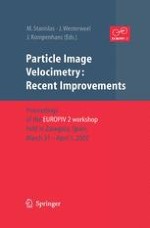2004 | OriginalPaper | Buchkapitel
Development and Assessment of Non-Isotropic Spatial Resolution in PIV
verfasst von : F. Scarano
Erschienen in: Particle Image Velocimetry: Recent Improvements
Verlag: Springer Berlin Heidelberg
Enthalten in: Professional Book Archive
Aktivieren Sie unsere intelligente Suche, um passende Fachinhalte oder Patente zu finden.
Wählen Sie Textabschnitte aus um mit Künstlicher Intelligenz passenden Patente zu finden. powered by
Markieren Sie Textabschnitte, um KI-gestützt weitere passende Inhalte zu finden. powered by
The present study discusses the development of a novel method to interrogate PIV recordings. The technique is introduced as an adaptive resolution in that it is based on the adaptation of the interrogation volume to the local flow field properties. In the first part the evaluation of the PIV spatial resolution based on cross-correlation is discussed. A comparison is proposed between the behaviour of moving average filters with the result of the cross-correlation operator. In both cases the operators act as spatial low-pass filters of the velocity distribution, while the difference is given by the additional error due to the noise level intrinsic of particle image correlation. The error due to the finite extent of the interrogation window is derived with an analytical expression. A local Taylor expansion truncated at the second order models the velocity two-dimensional distribution. The error analysis shows that the error is proportional to the velocity second derivative and to the square of the window (linear) size. p] The second part discusses the concept of non-isotropic resolution only possible in multi-dimensional signals. The method is based on the analysis of the velocity second derivatives. The Hessian tensor eigen-values/vectors describe the spatial curvature radius of the velocity distribution. This information is used to modify the aspect ratio of the interrogation window and to orient it in order to minimize the effects of the largest fluctuations. The proposed method is based on interrogation windows of elliptical shape, with a constant area and elongated in the direction of the largest radius of curvature. The implementation of the non-isotropic windowing method within a recursive interrogation scheme which also applies window deformation is described. The non-isotropic interrogation method performance is then assessed by means of Monte-Carlo simulation of particle images motion. The analysis of one-dimensional sinusoidal displacement yields the comparison with moving average filters. The results show that for the one-dimensional case the spatial resolution can be improved by a factor two. A final qualitative comparison is presented on a turbulent separated flow assessing the method robustness in case of real (noisy) PIV images.
